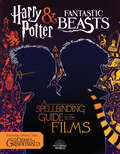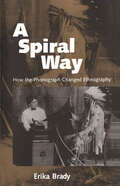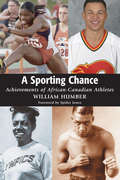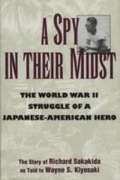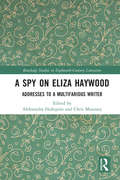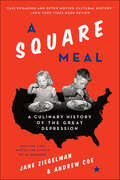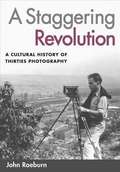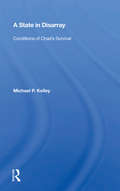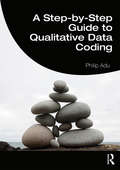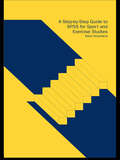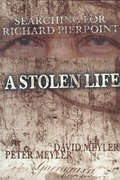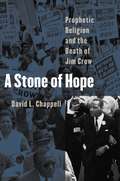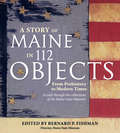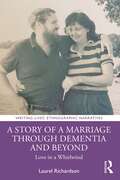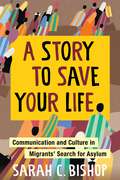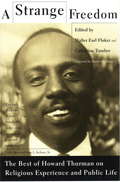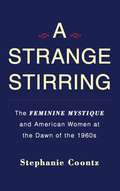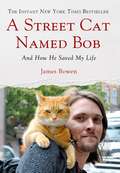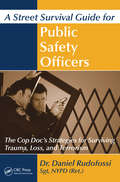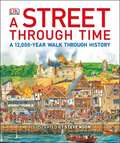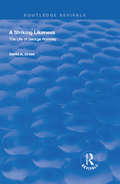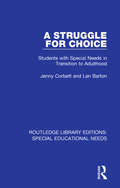- Table View
- List View
A Spellbinding Guide to the Films (Follow Me Around... Ser.)
by Michael KoggeFantastic Beasts: The Crimes of Grindelwald is coming to theaters November 16, 2018! Explore the new film series and its connections to Harry Potter with this beautiful handbook!As Fantastic Beasts: The Crimes of Grindelwald breaks new ground, it's time to get up to speed on the films of J.K. Rowling's wizarding world! This handy handbook has everything fans need to sort hippogriffs from horcruxes, trace the lineage of the most noble wizarding families, explore the different wizarding governments, and study Hogwarts from the early 1900s on. This beautiful guide is the perfect deep dive into Harry Potter and Fantastic Beasts and how the two worlds are connected, complete with family trees, infographics, and more.
A Spiral Way: How the Phonograph Changed Ethnography
by Erika BradyAssociation of Recorded Sound Collections Awards for ExcellenceBest Research in the General History of Recorded Sound (2000)The invention of the cylinder phonograph at the end of the nineteenth century opened up a new world for cultural research. Indeed, Edison's talking machine became one of the basic tools of anthropology. It not only equipped researchers with the means of preserving folk songs but it also enabled them to investigate a wide spectrum of distinct vocal expressions in the emerging fields of anthropology and folklore. Ethnographers grasped its huge potential and fanned out through regional America to record rituals, stories, word lists, and songs in isolated cultures. From the outset the federal government helped fuel the momentum to record cultures that were at risk of being lost. Through the Bureau of American Ethnology, the Smithsonian Institution took an active role in preserving native heritage. It supported projects to make phonographic documentation of American Indian language, music, and rituals before developing technologies and national expansion might futher undermine them. This study of the early phonograph's impact shows traditional ethnography being transformed, for attitudes of both ethnographers and performers were reshaped by this exciting technology. In the presence of the phonograph both fieldwork and the materials collected were revolutionized. By radically altering the old research modes, the phonograph brought the disciplines of anthropology and folklore into the modern era. At first the instrument was as strange and new to the fieldworkers as it was to their subjects. To some the first encounter with the phonograph was a deeply unsettling experience. When it was demonstrated in 1878 before members of the National Academy of Sciences, several members of the audience fainted. Even its inventor was astonished. Of his first successful test of his tinfoil phonograph, Thomas A. Edison said, "I was never taken so aback in my life." The cylinders that have survived from these times offer an unrivaled resource not only for contemporary scholarship but also for a grassroots renaissance of cultural and religious values. In tracing the historical interplay of the talking machine with field research, A Spiral Way underscores the natural adaptablity of cultural study to this new technology.
A Sporting Chance: Achievements of African-Canadian Athletes
by William Humber Spider JonesOver the years, Canadians have smugly asserted their country’s more tolerant culture in race relations. Yet as this story of African-Canadian participation in sports demonstrates, the record is far more troubling. In reality, Canada’s record in matters of race was a disturbing blend of occasional good intentions and ugly practices. The study of the Black athletic experience in Canada is not only a revealing portrait into our past, but also one more demonstration of some time-honoured truths about human achievement and the necessity of the public will to provide open and fair forums for equal access to participation. Presented in a chronological sequence, individual sports are presented along with the leading athletes who brought grace and a determination to achieve. Included are George Dixon, Sam Langford, Reuben Mayes, Ray Lewis, Sam Richardson, Dr. Phil Edwards, Jackie Robinson, Harry Jerome, Earl Walls, Donovan Bailey, Sylvia Sweeney, Molly Killingbeck, Herb Carnegie, Jamaal Magliore, Perdita Felicien and Jarome Iginla, to name but a few of the fine athletes who form a part of Canada’s sports heritage. "As Canada’s foremost baseball historian, Bill Humber has chronicled another fascinating chapter from Canada’s rich sports history. This is an excellent read – entertaining, educational and expertly researched. As my pal Don Cherry might say: ’Two thumbs up, Bill.’"– Brian McFarlane, Sports Family Ltd.
A Spy In Their Midst: The World War Ii Struggle Of A Japanese-american Hero
by Wayne S. Kiyosaki Richard Sakakida<P>During World War II, while thousands of Japanese-Americans were being sent to U.S. detainment camps, a Japanese-American from Hawaii working as a U.S. Army spy in the Philippines was captured by the enemy.<P> Richard Sakakida was the only Japanese-American prisoner of the Japanese forces, and he faced death as a "traitor" because of his Japanese face.<P> Despite unspeakable torture, Sakakida stubbornly refused to confess that he was an American spy; ironically, his Japanese cultural heritage is what enabled him to survive the beatings inflicted on him by his Japanese captors.<P> Sakakida narrowly escaped a death sentence and was assigned to the office of a Japanese official, where he gained valuable military information for MacArthur and engineered a daring prison break that freed a Filipino guerrilla leader and hundreds of his followers. <P>Fifty years later, Sakakida finally tells his tale of survival and perseverance against incredible odds.
A Spy on Eliza Haywood: Addresses to a Multifarious Writer (Routledge Studies in Eighteenth-Century Literature)
by Aleksondra HultquistEliza Haywood was one of the most prolific English writers in the Age of the Enlightenment. Her career, from Love in Excess (1719) to her last completed project The Invisible Spy (1755) spanned the gamut of genres: novels, plays, advice manuals, periodicals, propaganda, satire, and translations. Haywood’s importance in the development of the novel is now well-known. A Spy on Eliza Haywood links this with her work in the other genres in which she published at least one volume a year throughout her life, demonstrating how she contributed substantially to making women’s writing a locus of debate that had to be taken seriously by contemporary readers, as well as now by current scholars of political, moral, and social enquiries into the eighteenth century. Haywood’s work is essential to the study of eighteenth-century literature and this collection of essays continues the growing scholarship on this most important of women writers.
A Square Meal: A Culinary History of the Great Depression
by Jane Ziegelman Andrew CoeJames Beard Foundation Book Award WinnerFrom the author of the acclaimed 97 Orchard and her husband, a culinary historian, an in-depth exploration of the greatest food crisis the nation has ever faced—the Great Depression—and how it transformed America’s culinary culture.The decade-long Great Depression, a period of shifts in the country’s political and social landscape, forever changed the way America eats. Before 1929, America’s relationship with food was defined by abundance. But the collapse of the economy, in both urban and rural America, left a quarter of all Americans out of work and undernourished—shattering long-held assumptions about the limitlessness of the national larder.In 1933, as women struggled to feed their families, President Roosevelt reversed long-standing biases toward government-sponsored “food charity.” For the first time in American history, the federal government assumed, for a while, responsibility for feeding its citizens. The effects were widespread. Championed by Eleanor Roosevelt, “home economists” who had long fought to bring science into the kitchen rose to national stature.Tapping into America’s long-standing ambivalence toward culinary enjoyment, they imposed their vision of a sturdy, utilitarian cuisine on the American dinner table. Through the Bureau of Home Economics, these women led a sweeping campaign to instill dietary recommendations, the forerunners of today’s Dietary Guidelines for Americans.At the same time, rising food conglomerates introduced packaged and processed foods that gave rise to a new American cuisine based on speed and convenience. This movement toward a homogenized national cuisine sparked a revival of American regional cooking. In the ensuing decades, the tension between local traditions and culinary science has defined our national cuisine—a battle that continues today. A Square Meal examines the impact of economic contraction and environmental disaster on how Americans ate then—and the lessons and insights those experiences may hold for us today.A Square Meal features 25 black-and-white photographs.
A Staggering Revolution: A Cultural History of Thirties Photography
by John RaeburnDuring the 1930s, the world of photography was unsettled, exciting, and boisterous. John Raeburn's A Staggering Revolution recreates the energy of the era by surveying photography's rich variety of innovation, exploring the aesthetic and cultural achievements of its leading figures, and mapping the paths their pictures blazed public's imagination. While other studies of thirties photography have concentrated on the documentary work of the Farm Security Administration (FSA), no previous book has considered it alongside so many of the decade's other important photographic projects. A Staggering Revolution includes individual chapters on Edward Steichen's celebrity portraiture; Berenice Abbott's Changing New York project; the Photo League's ethnography of Harlem; and Edward Weston's western landscapes, made under the auspices of the first Guggenheim Fellowship awarded to a photographer. It also examines Margaret Bourke-White's industrial and documentary pictures, the collective undertakings by California's Group f.64, and the fashion magazine specialists, as well as the activities of the FSA and the Photo League.
A State In Disarray: Conditions Of Chad's Survival
by Michael P. KelleyAlthough independent since 1960, Chad has proved to be one of the least viable African states. Sustained politically and financially by other countries from the outset, Chad's internal warfare has made it the prey of external powers. Yet Chad has survived–an integral element of the Organization of African Unity's Pax Africana and of a peaceful trans-Saharan Africa. Its jeopardized survival is a shaky testimony to the continuing validity of the African continent's colonial-based states-system–underwritten by the OAU and the UN–and at the same time it provides a striking example of the cumulative effects of Africa's post-independence problems. Examining the state's internal weakness and the degree and nature of its foreign involvements, the author focuses on Chad's continuing dilemma: The outside support so crucial for viability is the very thing that undermines its international standing. The roles of Libya, France, the United States, the UN, the OAU, and the trans-Saharan regional subsystem are also analyzed as the author illuminates the quandary of supporting the state without aggravating its conflicts.
A Step-by-Step Guide to Applying the Rasch Model Using R: A Manual for the Social Sciences (Quantitative Methodology Series)
by Iasonas LamprianouThis new edition provides a step-by-step guide to applying the Rasch model in R, a probabilistic model used by researchers across the social sciences to measure unobservable (“latent”) variables. Although the focus is on simple R code, the book provides updated guidance through the point-and-click menus of BlueSky Statistics software.The book covers all Rasch models frequently used in social sciences, from the Simple Rasch model to the Rating Scale, Partial Credit, and Many-Facets Rasch models. Using a pragmatic approach to model-data fit, this book offers helpful practical examples to investigate Rasch model assumptions. In addition to traditional Rasch model approaches, it introduces the Rasch model as a special case of a Generalized Mixed Effects Model. Readers will also benefit from the online support material which includes all the code used in the book in downloadable and useable files.It also provides a comprehensive guide to R programming and practical guidance on using BlueSky Statistics software's point-and-click menus. This dual approach enables readers to experiment with data analysis using the provided data sets, enhancing their understanding and application of statistical concepts. It will be a valuable resource for both students and researchers who want to use Rasch models in their research.
A Step-by-Step Guide to Qualitative Data Coding
by Philip AduA Step-by-Step Guide to Qualitative Data Coding is a comprehensive qualitative data analysis guide. It is designed to help readers to systematically analyze qualitative data in a transparent and consistent manner, thus promoting the credibility of their findings. The book examines the art of coding data, categorizing codes, and synthesizing categories and themes. Using real data for demonstrations, it provides step-by-step instructions and illustrations for analyzing qualitative data. Some of the demonstrations include conducting manual coding using Microsoft Word and how to use qualitative data analysis software such as Dedoose, NVivo and QDA Miner Lite to analyze data. It also contains creative ways of presenting qualitative findings and provides practical examples. After reading this book, readers will be able to: Analyze qualitative data and present their findings Select an appropriate qualitative analysis tool Decide on the right qualitative coding and categorization strategies for their analysis Develop relationships among categories/themes Choose a suitable format for the presentation of the findings It is a great resource for qualitative research instructors and undergraduate and graduate students who want to gain skills in analyzing qualitative data or who plan to conduct a qualitative study. It is also useful for researchers and practitioners in the social and health sciences fields.
A Step-by-Step Guide to SPSS for Sport and Exercise Studies: A Step-by-Step Guide for Students
by Nikos NtoumanisSPSS is the international standard software package for data analysis in the social sciences. This book is the only SPSS guide designed specifically for students in the fields of sport, exercise and kinesiology. It Includes sport specific cases and data throughout.
A Stolen Life: Searching for Richard Pierpoint
by Peter Meyler David MeylerRichard Pierpoint or Captain Dick, as he was commonly known, emerges from the shadows of history in A Stolen Life: Searching for Richard Pierpoint. An African warrior who was captured at about age 16, Pierpoint lived his remaining years in exile. From his birth in Bundu (now part of Senegal) around 1744 until his death in rural Ontario in 1837, Pierpoint’s life allows us to glimpse the activity of an African involved in some of the world’s great events. "We are indebted to the authors for breathing life into this man, who though taken from his home early in his life still was able to make a significant contribution to the early history of Upper Canada. He fought, farmed and became a giant to the Black community. We thank you for a wonderful story of this often forgotten segment of Canadian history."— Wilma Morrison, Norval Johnson Heritage Library, Niagara Falls"Everybody knows about the Underground Railroad and the great many Black souls who emigrated to Canada via this route, but very few people know the brave Black men and women who put their lives on the line in defence of this country."— Ivor Christopher, Re-enactor, Runchey’s Company of Coloured Men"A well-researched and highly readable chronicle of Richard Pierpoint’s life in Africa and North America — as a slave, a soldier, and as a pioneer in Upper Canada’s wilderness. … a vitally important contribution to Canadian Black history."— Linda Brown-Kubisch, Author, Missouri
A Stone of Hope
by David L. ChappellThe civil rights movement was arguably the most successful social movement in American history. In a provocative new assessment of its success, David Chappell argues that the story of civil rights is not a story of the ultimate triumph of liberal ideas after decades of gradual progress. Rather, it is a story of the power of religious tradition.Chappell reconsiders the intellectual roots of civil rights reform, showing how northern liberals' faith in the power of human reason to overcome prejudice was at odds with the movement's goal of immediate change. Even when liberals sincerely wanted change, they recognized that they could not necessarily inspire others to unite and fight for it. But the prophetic tradition of the Old Testament--sometimes translated into secular language--drove African American activists to unprecedented solidarity and self-sacrifice. Martin Luther King Jr., Fannie Lou Hamer, James Lawson, Modjeska Simkins, and other black leaders believed, as the Hebrew prophets believed, that they had to stand apart from society and instigate dramatic changes to force an unwilling world to abandon its sinful ways. Their impassioned campaign to stamp out "the sin of segregation" brought the vitality of a religious revival to their cause. Meanwhile, segregationists found little support within their white southern religious denominations. Although segregationists outvoted and outgunned black integrationists, the segregationists lost, Chappell concludes, largely because they did not have a religious commitment to their cause.In a provocative assessment of the success of the civil rights movement, David Chappell reconsiders the intellectual roots of civil rights reform, showing how the prophetic tradition of the Old Testament--sometimes translated into secular language--drove African American activists to unprecedented solidarity and self-sacrifice. Martin Luther King Jr., Fannie Lou Hamer, James Lawson, Modjeska Simkins, and other black leaders believed, as the Hebrew prophets believed, that they had to stand apart from society and instigate dramatic changes to force an unwilling world to abandon its sinful ways. Although segregationists outvoted and outgunned black integrationists, the segregationists lost, Chappell concludes, largely because they did not have a religious commitment to their cause.-->
A Story of Maine in 112 Objects: From Prehistory To Modern Times
by Bernard P. FishmanPUBLISHED WITH THE MAINE STATE MUSEUM Founded in 1836, the Maine State Museum is America’s oldest state museum and is known to many as “Maine’s Smithsonian” because of the breadth and diversity of its holdings—nearly a million objects covering every aspect of the state’s cultural, biological, and geological history—and the thousands of stories its collections tell. For this book the museum selected and photographed 112 artifacts and specimens that, together, tell an epic story of the land and its people from prehistoric times to the present. It is a story covering 395 million years, a story told with a walrus skull and fossils, tourmaline and spear points, mammoth tusks and bone fishhooks, Norse coins and caulking irons, militia flags and survey stakes, treaty documents and wooden tankards, a temperance banner and a locomotive, Joshua Chamberlain’s pistol and a cod tub trawl, a Lombard log hauler and a woman’s WWII welding outfit, L. L. Bean boots and German POW snowshoes, and many more objects from the museum’s collections. Short narratives written by museum curators are woven around each item—including photos of related objects—and the ensemble has been honed, polished, and introduced by museum director Bernard Fishman. This is a book that historians and Maine residents and visitors will delve into again and again, unearthing new treasures with each reading.
A Story of a Marriage Through Dementia and Beyond: Love in a Whirlwind (Writing Lives: Ethnographic Narratives)
by Laurel RichardsonA Story of a Marriage Through Dementia and Beyond is the extraordinary, unflinching account from sociologist Laurel Richardson of her love and caregiving through the last period of her husband Ernest Lockridge's life - from his transient amnesia to his death from Lewy Body Dementia. Focusing on the lived experience of the caregiver through the loved one’s journey from mild cognitive impairment to death, the book gives the reader the experience of what the medical diagnoses mean and what has led up to the loss. It shows the complex, nuanced lives of a couple both living with the worst effects of a disease like Lewy Body Dementia, while maintaining, sometimes with hope and laughter, their loving connection nourished through a 40-year marriage. Dementia is a ‘silver tsunami’ - the third leading cause of death amongst senior populations. Richardson’s beautifully written book gives on-the-ground emotional support to those already in service as caregivers and helps prepare others for such service. Hospices, book clubs, and medical and allied professionals will find this book extraordinarily valuable. Weaving in autoethnographic and sociological methods and scholarship, as well as a list of reading and further resources for caregivers and scholars, this book will also appeal to courses in a wide range of disciplines and fields, including health communication, nursing and allied health, courses covering death and dying, end-of-life, and illness care, and, of course, scholars pursuing autoethnography, creative non-fiction, and qualitative methods.
A Story to Save Your Life: Communication and Culture in Migrants' Search for Asylum
by Sarah BishopA young woman flees violence in Mexico and seeks protection in the United States—only to be trafficked as a domestic worker in the Bronx. A decorated immigration judge leaves his post when the policies he proudly upheld capsize in the wake of political turmoil. A Gambian translator who was granted asylum herself talks with other African women about how immigration officers expect victims of torture to behave. A border patrol officer begins to question the training that instructs him to treat the children he finds in the Arizona desert like criminals.Through these and other powerful firsthand accounts, A Story to Save Your Life offers new insight into the harrowing realities of seeking protection in the United States. Sarah C. Bishop argues that cultural differences in communication shape every stage of the asylum process, playing a major but unexamined role. Migrants fleeing persecution must reconstruct the details of their lives so governmental authorities can determine whether their experiences justify protection. However, Bishop shows, many factors influence whether an applicant is perceived as credible, from the effects of trauma on the ability to recount an experience chronologically to culturally rooted nonverbal behaviors and displays of emotion. For asylum seekers, harnessing the power of autobiographical storytelling can mean the difference between life and death. A Story to Save Your Life emphasizes how memory, communication, and culture intertwine in migrants’ search for safety.
A Strange Freedom
by Howard ThurmanA spiritual advisor to Martin Luther King, Jr.; the first black dean at a white university; cofounder of the first interracially pastored, intercultural church in the United States, Howard Thurman offered a transcendent vision of our world. This lyrical collection of select published and unpublished works traces his struggle with the particular manifestations of violence and hatred that mark the twentieth century. His words remind us all that out of religious faith emerges social responsibility and the power to transform lives.
A Strange Stirring: The Feminine Mystique and American Women at the Dawn of the 1960s
by Stephanie CoontzIn 1963, Betty Friedan unleashed a storm of controversy with her bestselling book, The Feminine Mystique. Hundreds of women wrote to her to say that the book had transformed, even saved, their lives. Nearly half a century later, many women still recall where they were when they first read it. In A Strange Stirring, historian Stephanie Coontz examines the dawn of the 1960s, when the sexual revolution had barely begun, newspapers advertised for "perky, attractive gal typists," but married women were told to stay home, and husbands controlled almost every aspect of family life. Based on exhaustive research and interviews, and challenging both conservative and liberal myths about Friedan, A Strange Stirring brilliantly illuminates how a generation of women came to realize that their dissatisfaction with domestic life didn't reflect their personal weakness but rather a social and political injustice.
A Street Cat Named Bob: And How He Saved My Life
by James BowenThe Instant New York Times Bestseller! James is a street musician struggling to make ends meet. Bob is a stray cat looking for somewhere warm to sleep. When James and Bob meet, they forge a never-to-be-forgotten friendship that has been charming readers from Thailand to Turkey. A Street Cat Named Bob is an international sensation, landing on the bestseller list in England for 52 consecutive weeks and selling in 26 countries around the world. Now, James and Bob are ready to share their true story with the U. S. in this tale unlike any you’ve ever read of a cat who possesses some kind of magic. When street musician James Bowen found an injured cat curled up in the hallway of his apartment building, he had no idea how much his life was about to change. James was living hand to mouth on the streets of London, barely making enough money to feed himself, and the last thing he needed was a pet. Yet James couldn't resist helping the strikingly intelligent but very sick animal, whom he named Bob. He slowly nursed Bob back to health and then sent the cat on his way, imagining that he would never see him again. But Bob had other ideas. Perfect for fans of Marley & Me: Life and Love with the World's Worst Dog and Dewey: The Small-Town Library Cat That Changed the World, this instant classic about the power of love between man and animal has taken the world by storm and is guaranteed to be a huge hit with American fans as well. Note: Does not use standard American spelling or punctuation.
A Street In Marrakech: A Personal View of Urban Women in Morocco
by Elizabeth Warnock FerneaThis is a reflexive account of an American woman and her family's unpredictable journey through the private and public worlds of a traditional Muslim city in the process of change. As a Western stranger in Marrakech, Fernea was met with suspicion and hostility. The story of the slow growth of trust and acceptance between the author and her Moroccan neighbors involves the reader in everyday activities, weddings, funerals, and women's rituals. Both the author and her friends are changed by the encounters that she describes. This is a crosscultural adventure, ethnographically sound, and written in an accessible style.
A Street Survival Guide for Public Safety Officers: The Cop Doc's Strategies for Surviving Trauma, Loss, and Terrorism
by Daniel RudofossiAn expansion of Dr. Rudofossi's theory of Police and Public Safety Complex Trauma, this text integrates other models of trauma and loss into a one-of-a-kind intervention model. It offers insider perspectives from police psychologists, police managers, and clinicians describing what police personnel experience on the job, along with expert intervent
A Street Through Time
by Dorling KindersleyThis book views a street by the river through the ages and how it has evolved.
A Street Through Time: A 12,000 Year Journey Along the Same Street (DK Panorama)
by DKHave you ever wondered what your street was like thousands of years ago? This illustrated history book for children takes you on a 12,000-year journey to find out the story of a single street.Think of the street you live on. Now think of how it may have looked in the Stone Age in 10,000 BCE, or in Victorian times during the Industrial Revolution, or how it may look 50 years from now. A Street Through Time takes you on a time-traveling journey that you won't forget. Highly detailed illustrations bring 15 key periods in time to life. You will see magnificent buildings go up and come down, new churches built on the site of ancient temples, wooden bridges destroyed and then remade in stone, and statues demolished then unearthed many years later. You'll find out how people lived long ago - the tools they used, what they wore, and what they did all day. Revised and updated for a new generation, A Street Through Time now includes a look at the street 50 years in the future.
A Striking Likeness: The Life of George Romney
by David A CrossThis title was first published in 2000: In their stunning simplicity, George Romney's portraits of eighteenth-century gentry and their children are among the most widely recognised creations of his age. A rival to Reynolds and Gainsborough, Romney was born in 1734 on the edge of the Lake District, the landscape of which never ceased to influence his eye for composition and colour. He moved in 1762 to London where there was an insatiable market for portraits of the landed gentry to fill the elegant picture galleries of their country houses. Romney's sitters included William Beckford and Emma Hart, later Lady Hamilton. An influential figure, one of the founding fathers of neo-classicism and a harbinger of romanticism, Romney yearned to develop his talents as a history painter. Countless drawings bear witness to ambitious projects on elemental themes which were rarely executed on canvas. Richly illustrated, this is the first biography of Romney to explore the full diversity of his oeuvre.
A Struggle for Choice: Students with Special Needs in Transition to Adulthood (Routledge Library Editions: Special Educational Needs #8)
by Jenny Corbett Len BartonFirst published in 1992. For disabled people and people with learning difficulties the transition from school to college, work or training can be stressful and frustrating; job choices are often restricted, and they face barriers which are beyond their control. This book is about their struggle for choice. It sets special needs in further education in a socio-political context. By exploring the concept of ‘transition to adulthood’ in terms of class, race, gender and disability differences, and relating it to social, economic and political influences, it seeks to challenge complacency and encourage dialogue and debate.
